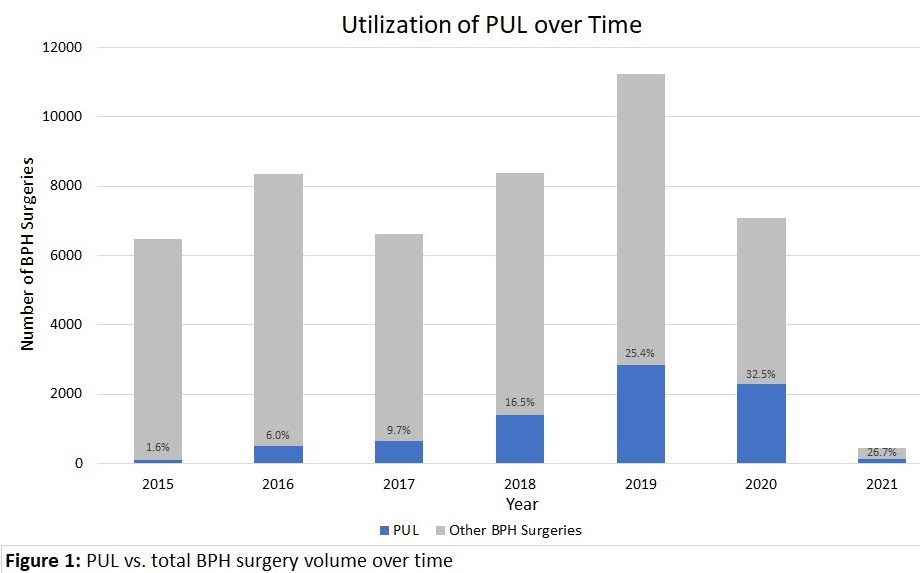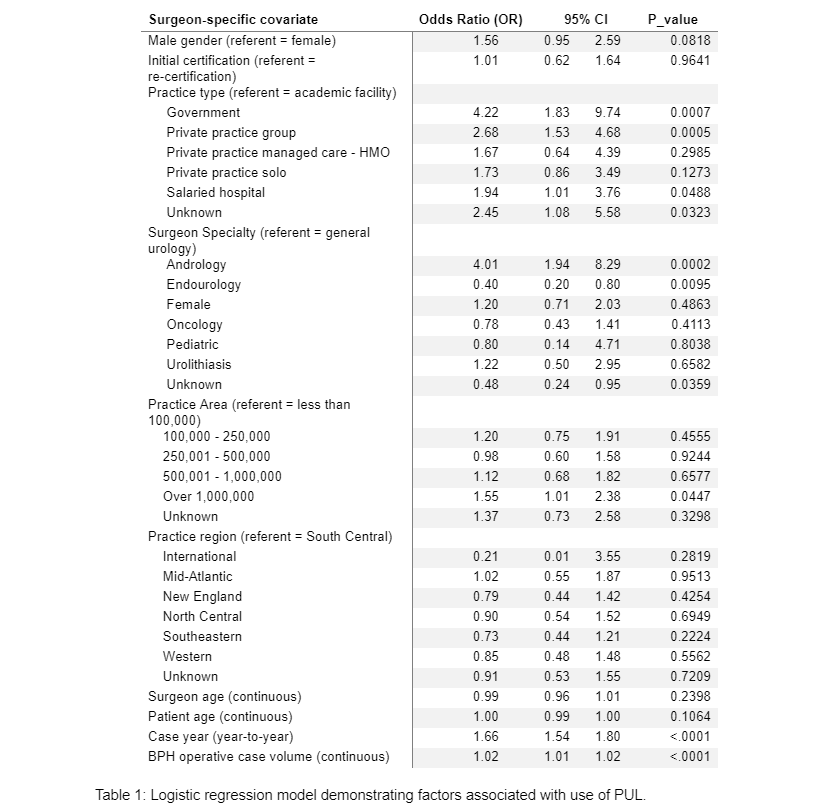Back
Poster, Podium & Video Sessions
MP01: Benign Prostatic Hyperplasia: Surgical Therapy & New Technology I
MP01-07: Factors associated with use of prostatic urethral lift (PUL)
Friday, May 13, 2022
7:00 AM – 8:15 AM
Location: Room 228
Samantha L. Thorogood*, Tenny R. Zhang, Christina Sze, Gina DeMeo, Mary O. Strasser, Richard K. Lee, Bilal Chughtai, Alexis Te, Jim C. Hu, New York, NY

Samantha Thorogood, MD
NewYork Presbyterian/Weill Cornell Medical College
Poster Presenter(s)
Introduction: PUL vs. other benign prostatic hyperplasia (BPH) surgical approaches improves preservation of antegrade ejaculation and shortens both operative time and postoperative catheterization. We investigated trends associated with its use.
Methods: We obtained de-identified, self-reported American Board of Urology (ABU) case logs from 2015-2021. We identified 4,131 urologists who performed 48,610 surgeries with an indication for BPH per ICD coding. CPT codes distinguished BPH surgical approaches. We identified 786 urologists who performed 7,895 PUL: 24 urologists only performed PUL, and 3,345 urologists did not perform any PUL. A logistic regression model assessed factors independently associated with PUL use.
Results: Annual PUL surgeon volume ranged from 101 to 2,852 cases; PUL comprised 1.6% of BPH surgeries in 2015 and increased to 32.5% in 2020. In adjusted analyses (Table 1), factors associated with higher odds of performing PUL included subspecialization in andrology (odds ratio [OR] 4.01, 95% CI 1.94-8.29); practice area population >1,000,000 (OR 1.55, 95% CI 1.01-2.38); and government (OR 4.22, 95% CI 1.83-9.74), private practice group (OR 2.68, 95% CI 1.53-4.68), and salaried hospital employment (OR 1.94, 95% CI 1.00-3.96). The operative year (OR 1.66 per year, 95% CI 1.54-1.80) and surgeon BPH surgical volume (OR 1.02 per case increase, 95% CI 1.01-1.02) were associated with increased odds of performing PUL. Endourology subspecialization was associated with lower odds of PUL (OR 0.40, 95% CI 0.2-0.8). Geographic region, surgeon age, surgeon gender, certification vs recertification status, and patient age were not associated with PUL use.
Conclusions: PUL utilization varies based on subspecialization, practice area, practice type, and BPH surgeon volume. Use of PUL has increased significantly and currently comprises one third of all BPH surgeries. More study is needed to determine durability of PUL outcomes particularly given its current widespread use and increasing adoption.
Source of Funding: None


Methods: We obtained de-identified, self-reported American Board of Urology (ABU) case logs from 2015-2021. We identified 4,131 urologists who performed 48,610 surgeries with an indication for BPH per ICD coding. CPT codes distinguished BPH surgical approaches. We identified 786 urologists who performed 7,895 PUL: 24 urologists only performed PUL, and 3,345 urologists did not perform any PUL. A logistic regression model assessed factors independently associated with PUL use.
Results: Annual PUL surgeon volume ranged from 101 to 2,852 cases; PUL comprised 1.6% of BPH surgeries in 2015 and increased to 32.5% in 2020. In adjusted analyses (Table 1), factors associated with higher odds of performing PUL included subspecialization in andrology (odds ratio [OR] 4.01, 95% CI 1.94-8.29); practice area population >1,000,000 (OR 1.55, 95% CI 1.01-2.38); and government (OR 4.22, 95% CI 1.83-9.74), private practice group (OR 2.68, 95% CI 1.53-4.68), and salaried hospital employment (OR 1.94, 95% CI 1.00-3.96). The operative year (OR 1.66 per year, 95% CI 1.54-1.80) and surgeon BPH surgical volume (OR 1.02 per case increase, 95% CI 1.01-1.02) were associated with increased odds of performing PUL. Endourology subspecialization was associated with lower odds of PUL (OR 0.40, 95% CI 0.2-0.8). Geographic region, surgeon age, surgeon gender, certification vs recertification status, and patient age were not associated with PUL use.
Conclusions: PUL utilization varies based on subspecialization, practice area, practice type, and BPH surgeon volume. Use of PUL has increased significantly and currently comprises one third of all BPH surgeries. More study is needed to determine durability of PUL outcomes particularly given its current widespread use and increasing adoption.
Source of Funding: None



.jpg)
.jpg)